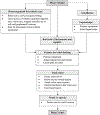Barriers to safety and efficiency in robotic surgery docking
- PMID: 33469695
- PMCID: PMC8286975
- DOI: 10.1007/s00464-020-08258-0
Barriers to safety and efficiency in robotic surgery docking
Abstract
Background: The introduction of new technology into the operating room (OR) can be beneficial for patients, but can also create new problems and complexities for physicians and staff. The observation of flow disruptions (FDs)-small deviations from the optimal course of care-can be used to understand how systems problems manifest. Prior studies showed that the docking process in robotic assisted surgery (RAS), which requires careful management of process, people, technology and working environment, might be a particularly challenging part of the operation. We sought to explore variation across multiple clinical sites and procedures; and to examine the sources of those disruptions.
Methods: Trained observers recorded FDs during 45 procedures across multiple specialties at three different hospitals. The rate of FDs was compared across surgical phases, sites, and types of procedure. A work-system flow of the RAS docking procedure was used to determine which steps were most disrupted.
Results: The docking process was significantly more disrupted than other procedural phases, with no effect of hospital site, and a potential interaction with procedure type. Particular challenges were encountered in room organization, retrieval of supplies, positioning the patient, and maneuvering the robot.
Conclusions: Direct observation of surgical procedures can help to identify approaches to improve the design of technology and procedures, the training of staff, and configuration of the OR environment, with the eventual goal of improving safety, efficiency and teamwork in high technology surgery.
Keywords: Flow disruptions; Human factors; Robotics; Safety; Surgery; Teamwork.
© 2021. The Author(s), under exclusive licence to Springer Science+Business Media, LLC part of Springer Nature.
Conflict of interest statement
Figures
References
-
- Baik SH, Kwon HY, Kim JS, Hur H, Sohn SK, Cho CH, Kim H (2009) Robotic versus laparoscopic low anterior resection of rectal cancer: short-term outcome of a prospective comparative study. Ann SurgOncol 16:1480–1487 - PubMed
-
- Ashrafian H, Clancy O, Grover V, Darzi A (2017) The evolution of robotic surgery: surgical and anaesthetic aspects. BJA: Br J Anaesth 119:i72–i84 - PubMed
-
- Cunningham S, Chellali A, Jaffre I, Classe J, Cao C (2013) Effects of experience and workplace culture in human-robot team interaction in robotic surgery: a case study. Int J Soc Robot 5:75–88. 10.1007/s12369-012-0170-y - DOI
Publication types
MeSH terms
Grants and funding
LinkOut - more resources
Full Text Sources
Other Literature Sources



